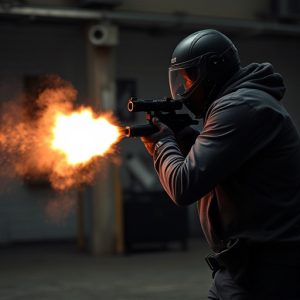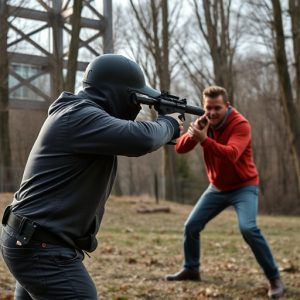Taser vs Stun Gun: Differences & Responsible Online Purchase Guide
Non-lethal stun guns, easily accessible online, offer individuals and law enforcement a safer altern…….
Non-lethal stun guns, easily accessible online, offer individuals and law enforcement a safer alternative to firearms for personal security and crowd control. These devices temporarily incapacitate targets through electrical current disruption, with tasers deploying probes via wires and stun guns firing high-voltage pulses. When choosing among various models, users must consider effectiveness, range, and legal implications in their jurisdictions. Online purchasing convenience highlights growing interest in these tools, but understanding regional regulations and proper training is crucial for responsible use to minimize risks.
“In today’s world, understanding non-lethal weapons is crucial for personal safety and security. This article offers a comprehensive guide to Tasers and stun guns—two popular non-lethal devices. We’ll explore their distinct designs, functionalities, and real-world applications. From legal considerations for online purchase and ownership to safety precautions and training, we delve into the responsible use of these tools. Whether you’re a concerned citizen or a professional in need of self-defense, this guide provides insights into choosing and using non-lethal stun guns online.”
- Understanding Non-Lethal Weapons: A Brief Overview
- Tasers: Design, Functionality, and Applications
- Stun Guns: Features, Types, and User Experience
- Legal Considerations for Online Purchase and Ownership
- Safety Precautions and Training: Responsible Use of Non-Lethal Devices
Understanding Non-Lethal Weapons: A Brief Overview

Non-lethal weapons, such as stun guns and tasers, are designed to incapacitate or temporarily disable a target without causing permanent harm or death. These tools have gained significant attention, especially in law enforcement and self-defense contexts, as they offer an alternative to traditional firearms. For individuals seeking non-lethal options for personal safety, purchasing these devices online has become more accessible, raising awareness about their capabilities and limitations.
Stun guns and tasers both utilize electrical current to disrupt muscle control, leading to a temporary loss of balance and consciousness. However, the key difference lies in their design and deployment. Tasers typically fire two probes connected by thin wires, delivering an electric shock from a distance. In contrast, stun guns resemble traditional firearms and fire a single high-voltage pulse via a conductive probe, making them easier to handle for those unfamiliar with advanced equipment. Understanding these distinctions is crucial when choosing between non-lethal weapons, especially when considering their effectiveness, range, and potential legal implications in various jurisdictions.
Tasers: Design, Functionality, and Applications

Tasers, officially known as Electronic Control Devices (ECDs), are designed to temporarily incapacitate a person through electrical impulsification. They typically consist of two probes connected by thin wires to a main unit that fires an electric charge when activated. This charge disrupts muscle control, causing the target to experience powerful contractions, leading to temporary immobilization.
The functionality of tasers offers a non-lethal alternative to traditional law enforcement tools. They are often used for crowd control and to subdue resistant individuals without resorting to physical force or deadly weaponry. With their ability to disable targets from a distance, tasers provide officers with a tactical advantage during high-risk situations, making them readily available non-lethal stun guns online for authorized personnel worldwide.
Stun Guns: Features, Types, and User Experience

Stun guns are non-lethal self-defense tools designed to temporarily incapacitate an attacker through electric shock. They operate by delivering a high voltage, low current electrical pulse through two metal probes, disrupting muscle control and causing intense pain. These devices come in various types, including hand-held models, stun batons, and even hidden or concealable options suitable for everyday carry.
When it comes to user experience, stun guns are typically easy to operate. A simple press of a trigger releases the electric shock, offering users a quick response during emergencies. However, factors like range, power output, and charging requirements differ among models, influencing the overall effectiveness and convenience for individual needs. Purchasing non-lethal stun guns online provides access to a wide array of options, allowing buyers to select based on specific features that cater to their safety and security requirements.
Legal Considerations for Online Purchase and Ownership

When considering the purchase of non-lethal stun guns online, it’s crucial to be aware of legal considerations that come into play. The regulations surrounding stun guns vary greatly depending on your location, and what may be legal in one region could be restricted or outright banned in another. Before making a purchase, research your local laws and ensure you understand the requirements for ownership and use. Online retailers will often provide detailed information about shipping restrictions and legal compliance to help customers make informed decisions.
Many countries have specific categories for stun devices, with distinct power levels and use cases permitted under each category. Some may require licenses or permits for possession, while others might limit the size, voltage, or style of stun guns allowed. It’s essential to stay updated on any changes in legislation and consult official sources to avoid legal complications. Additionally, understanding the potential penalties for unauthorized ownership or misuse can deter criminal activities and ensure responsible acquisition and utilization of non-lethal stun guns.
Safety Precautions and Training: Responsible Use of Non-Lethal Devices

When considering the responsible use of non-lethal devices like stun guns or tasers, safety precautions and proper training are paramount. It’s crucial to understand that these tools are not entirely risk-free. Users must be educated on safe handling practices, including learning to identify and avoid situations where their use could cause unintended harm. Many online resources, including reputable manufacturers, offer comprehensive guides and training videos for responsible stun gun ownership.
Training should cover the device’s range, activation mechanisms, and deactivation processes. It’s also essential to learn about legal implications and local regulations regarding non-lethal self-defense devices. Proper training ensures users can effectively deploy these tools in real-life scenarios while minimizing potential risks to themselves and others.
When considering non-lethal weapons, such as tasers or stun guns, understanding their unique differences is key. Tasers, with their ability to temporarily incapacitate through electrical pulses, offer a specialized application in law enforcement and personal defense. Meanwhile, stun guns, featuring high-voltage electrical discharge, provide a broader range of options for self-defense enthusiasts. Purchasing these devices online can be convenient, but it’s crucial to familiarize yourself with legal restrictions and safety guidelines. Responsible use requires proper training, ensuring these powerful tools are employed effectively while minimizing risks.


